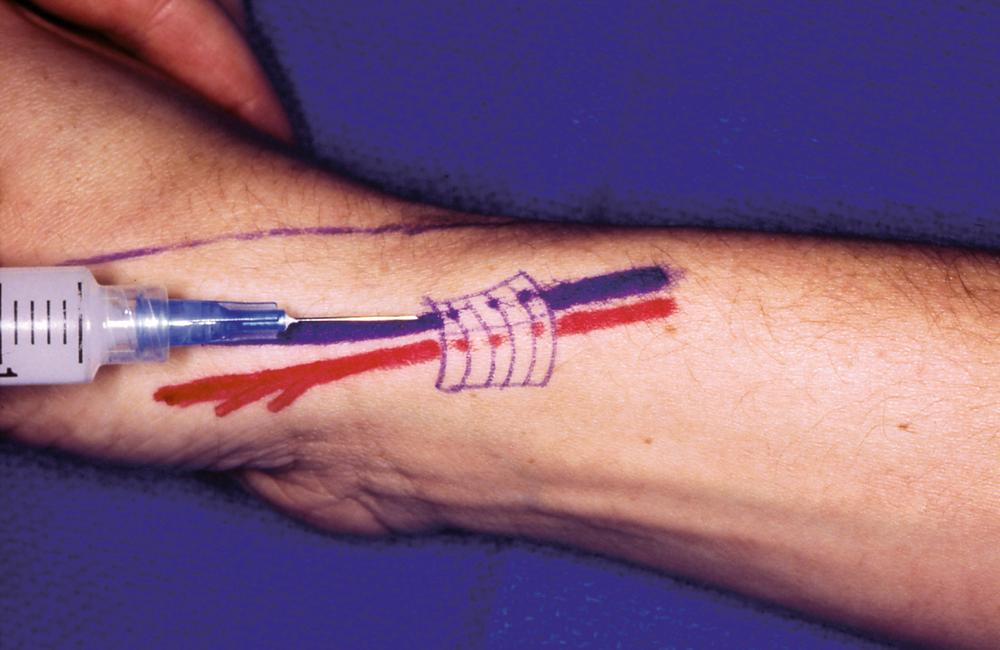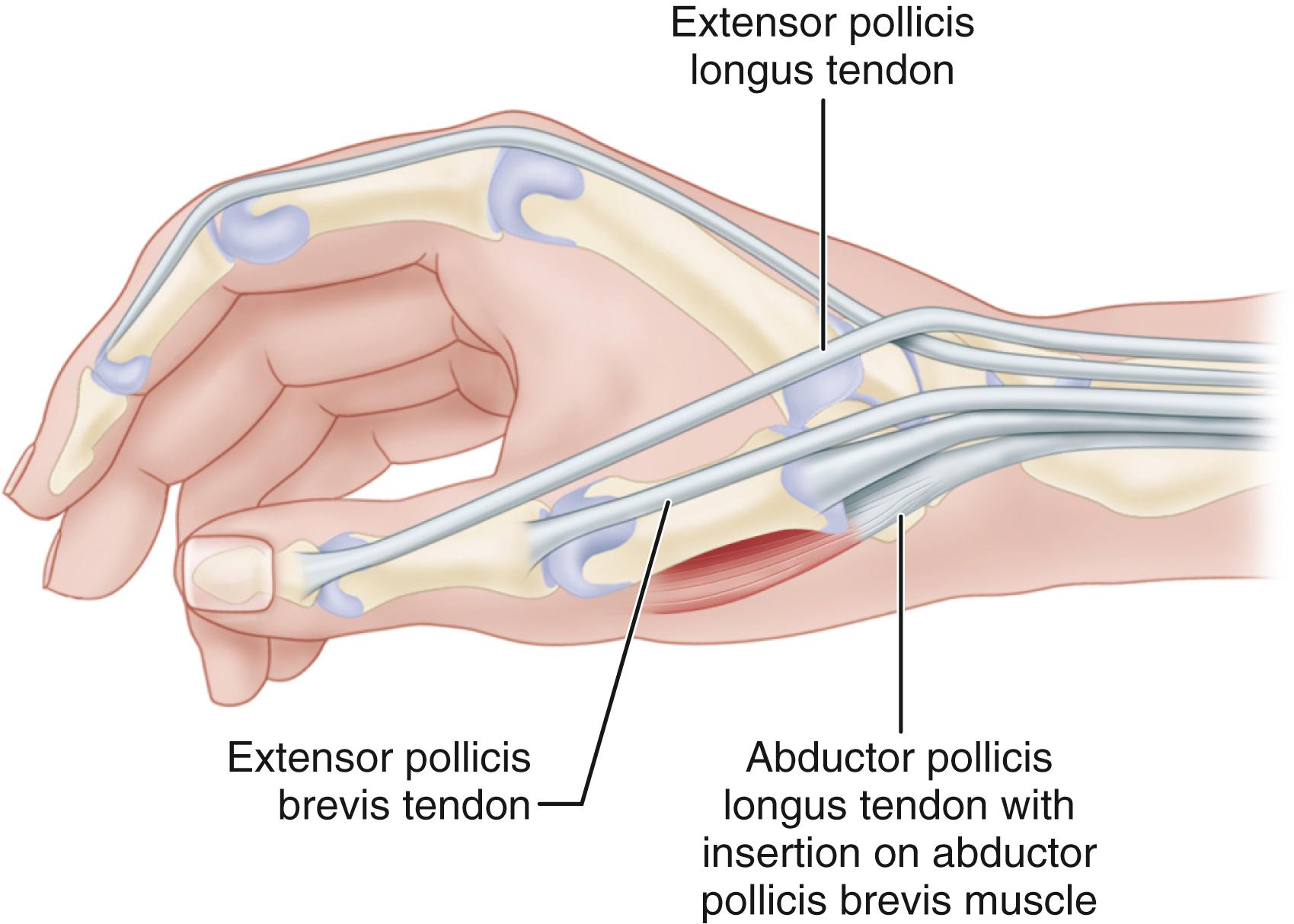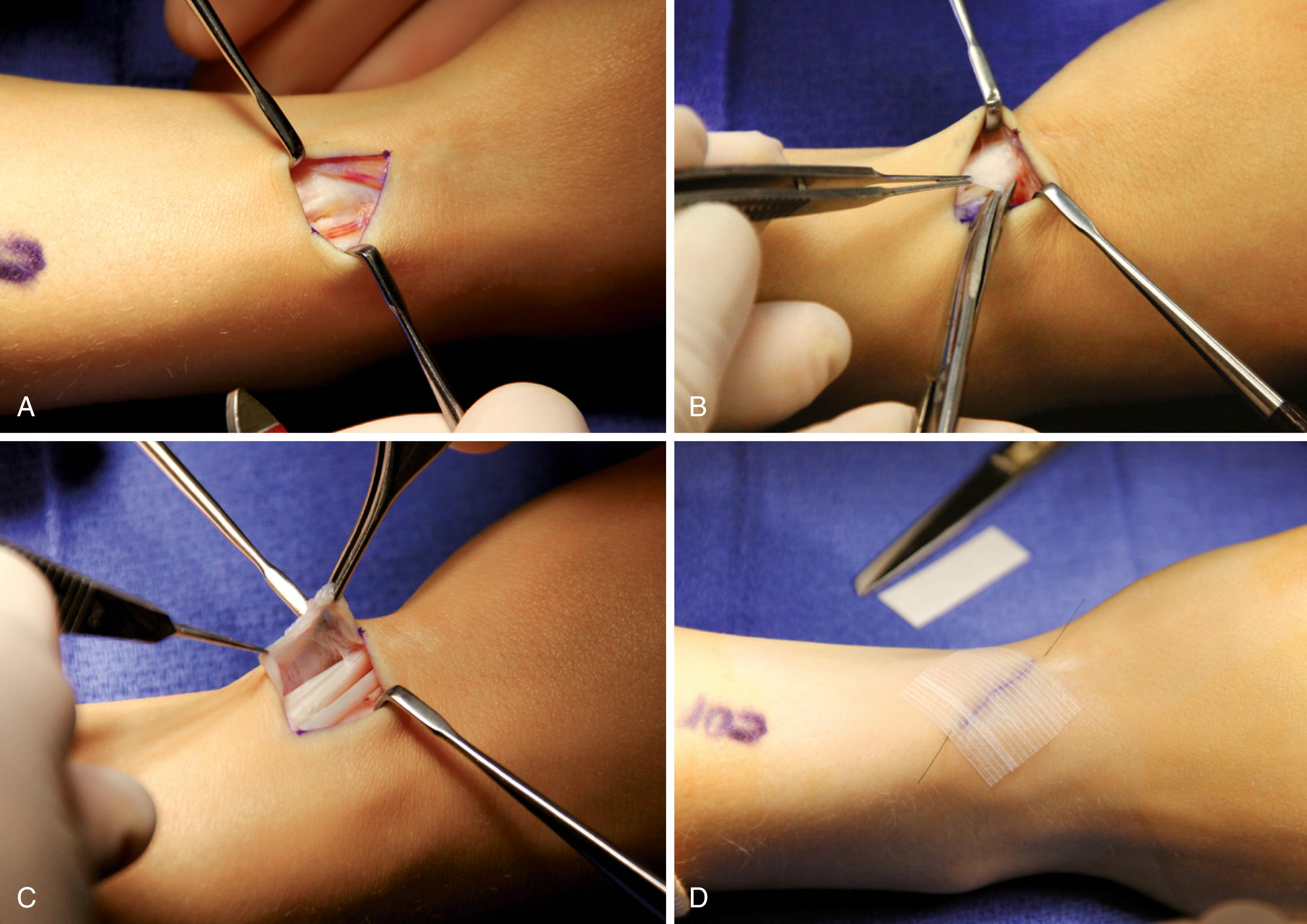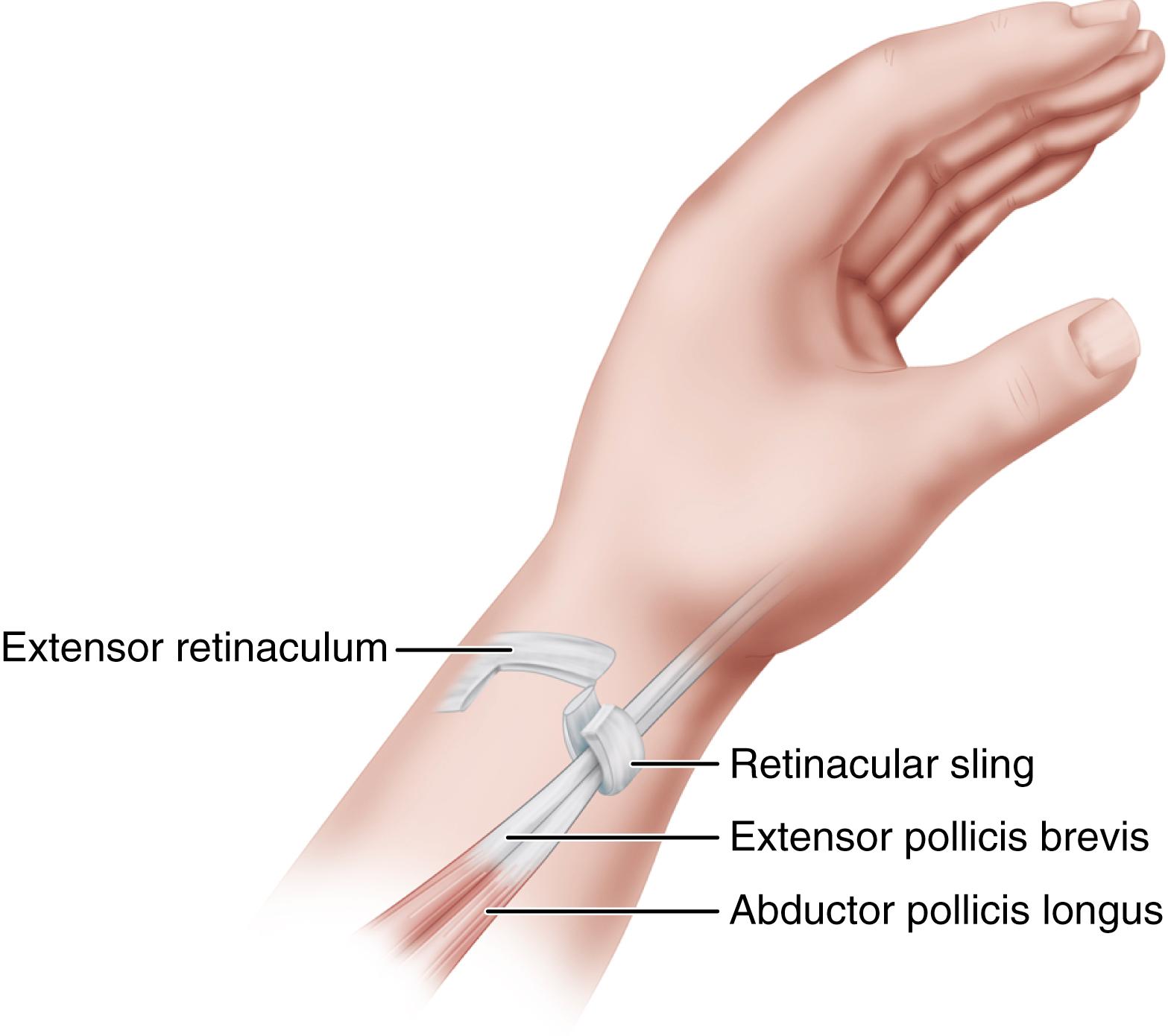Physical Address
304 North Cardinal St.
Dorchester Center, MA 02124
Stenosing tenosynovitis in the hand and wrist are common conditions resulting in significant functional impairment for which treatments usually are straightforward; symptom resolution usually is complete with appropriate management. When the extensor pollicis brevis (EPB) and the abductor pollicis longus (APL) tendons in the first dorsal compartment are affected, the condition is named after the Swiss physician Fritz de Quervain, who described this malady in 1895. A peritendinitis also may affect these tendons proximal to the extensor retinaculum, causing pain, swelling, and crepitus in some patients. Cysts attached to the first dorsal compartment retinaculum and tendon triggering may also occur.
The long flexor tendons to the thumb and fingers may develop focal areas of swelling resulting in mechanical symptoms at various tendon pulley interfaces. Less often, the extensor pollicis longus may be affected at the level of Lister tubercle. Any of the other tendons that pass beneath the dorsal wrist retinaculum also may be involved. The tenosynovitis that precedes the stenosis may result from an otherwise subclinical collagen disease or recurrent mild trauma, such as that experienced by carpenters and wait staff. Some case histories indicate that acute trauma may initiate the pathologic condition; however, most commonly these conditions develop gradually with no known cause. The stenosis occurs at a point where the direction of a tendon changes, for here a fibrous sheath acts as a pulley and friction is maximal. Although the tenosynovium lubricates the sheath, friction can cause a reaction when the repetition of a particular movement is necessary.
Many cases of tenosynovitis in various locations, even stenosing tenosynovitis, respond favorably to nonoperative intervention such as rest, antiinflammatory medications, and corticosteroid injections. Pain may increase temporarily during the initial 24 hours after loss of the local anesthetic effect; the patient should be warned about this possibility. It may be 3 to 7 days before the steroid becomes effective, but surgery is avoided in many instances. Before injection, it should be determined that the tenosynovitis is not caused by other conditions, such as gout or infection, which could be worsened by steroid injections. Patients with diabetes mellitus should be counseled about the potential rise in blood sugars for days following injection; patients with prior unfavorable response or brittle bone disease are not candidates for this treatment.
Most often, triggering digits are from flexor tendon-pulley pathology; however, it is important to evaluate for metacarpophalangeal joint arthritis and extensor tendon subluxation. Middle finger osteoarthritis may mimic middle trigger finger, and dorsal metacarpophalangeal joint swelling and joint space narrowing on radiographic examination usually clarify the distinction between these two entities. Oddly, trigger finger in conjunction with osteoarthritis is rare, and symptoms are unlikely to resolve with treatment of the trigger finger alone. Similarly, extensor tendon subluxation may be mistaken for simple trigger finger conditions. A sudden radial or ulnar shift of the finger associated with snapping or triggering of the finger should alert the examiner to check the dorsum of the hand for extensor tendon instability over the metacarpophalangeal joint. Similarly, coexistent trigger finger with extensor tendon subluxation is rare, and management of the extensor tendon alone usually is warranted.
Stenosing tenosynovitis of the APL and EPB tendons typically occurs in adults 30 to 50 years old; however, in women of childbearing age radial-sided wrist pain is commonly related to de Quervain tenosynovitis from repetitive ulnar deviation required in newborn care. Women are affected 6 to 10 times more frequently than men. The cause is almost always related to overuse, either in the home or at work, or is associated with rheumatoid arthritis. The presenting symptoms usually are pain and tenderness at the radial styloid. Sometimes a thickening of the fibrous sheath is palpable. The Finkelstein test usually is positive: “on grasping the patient’s thumb and quickly abducting the hand ulnarward, the pain over the styloid tip is excruciating.” Although Finkelstein stated that this test is “probably the most pathognomonic objective sign,” it is not diagnostic; the patient’s history and occupation, the radiographs, and other physical findings also must be considered. Similar symptoms also can be caused by arthritis in the trapeziometacarpal, scaphotrapeziotrapezoid, and radiocarpal joints; superficial radial nerve entrapment or neuroma; and tenosynovitis at the crossing of the EPB and APL over the extensor carpi radialis longus and brevis (intersection syndrome).
Conservative treatment consisting of splint wear and the injection of a steroid preparation ( Fig. 76.1 ) may be successful early after onset. Initial treatment with steroid injections may yield complete pain relief in over 70% of patients. When pain persists, surgery is the treatment of choice.

Anatomic variations are common in the first dorsal compartment, and separate compartments have been noted in 21% of anatomic specimens. Reports of separate compartments found at surgery vary from 20% to 58%. More than half of patients may have “aberrant” or duplicated tendons (usually the APL). These tendons sometimes insert more proximally and medially than usual, into the trapezium ( Fig. 76.2 ), the abductor pollicis brevis muscle ( Fig. 76.3 ), the opponens pollicis muscle, or the muscle fascia. The EPB is considered a “late” tendon phylogenetically and is absent in about 5% of wrists. The presence of these variations and failure to deal with them at the time of surgery may account for any persistence of pain.


Use a local anesthetic and a tourniquet.
Infiltrate the skin well proximal to the area of the first dorsal compartment with sufficient local anesthetic before skin preparation and draping. An Esmarch bandage on the proximal forearm usually suffices as a tourniquet.
Make an incision carefully through the skin only. An oblique incision coursing along the extensor brevis tendon is preferred; however, a transverse, oblique, or longitudinal incision is also perfectly satisfactory ( Fig. 76.4 ). The longitudinal incision advocated by some surgeons creates a longer area in which skin scar may make cutaneous nerves more subject to scar adherence.

Carry sharp dissection just through the dermis and not into the subcutaneous fat, avoiding the sensory branches (lateral antebrachial cutaneous nerve above the cephalic vein and superficial radial nerve branches more deeply).
After retracting the skin edges, use blunt dissection in the subcutaneous fat to clearly expose the retinaculum over the first dorsal compartment tendons.
Identify the first dorsal compartment tendons proximal to the stenosing dorsal ligament and sheath and open the first dorsal compartment on its dorsoulnar side. The EPB tendon is most dorsal and can be identified by its distally oriented muscle fibers; the APL tendon has no muscular fibers in this area.
With the thumb abducted and the wrist flexed, lift the APL and the EPB tendons from their groove. If they cannot be easily retracted from the radial styloid, look for additional “aberrant” tendons and separate compartments. Releasing the EPB tendon first and then the APL usually reveals the presence or absence of a septum. If there is no EPB present, inspect the floor of the compartment for the footprint of the brachioradialis tendon. This has a Y-shaped tendinous insertion; if this is clearly seen, release of this compartment is assured. Sometimes the septum is quite pronounced, and its resection is warranted, ensuring not to injure the underlying radial artery coursing dorsally just beyond the radial styloid.
Make sure that the volarly based retinacular flap remains over the released tendons to prevent volar tendon subluxation.
Close the skin incision only and apply a small pressure dressing.
The small pressure dressing is removed after 48 hours; an additional dressing can be applied if needed. Thumb and hand motion is immediately encouraged and is increased as tolerated, except for forceful wrist flexion, which may predispose the tendons toward subluxation during the first 2 weeks after surgery.
Failure to obtain complete relief after surgery may result from (1) neural adhesions or neuroma formation, (2) volar tendon subluxation, (3) failure to find and release a separate aberrant tendon within a separate compartment, (4) scar hypertrophy, or (5) incorrect diagnosis such as a bone lesion in the distal radius, intersection syndrome, localized arthritic deformities, or more proximal nerve compression syndromes. For recurrent subluxation of the EPB and APL tendons, a distally based brachioradialis tendon slip can be used to reconstruct a nonstenosing compartment to house the first dorsal compartment tendons. Ramesh and Britton used the extensor retinaculum to prevent subluxation ( Fig. 76.5 ). Littler et al. also described a reconstruction for the first compartment in which the septum dividing the first extensor compartment is removed, the EPB is removed from the compartment, and the retinacular sheath is reapproximated loosely over the APL tendon to prevent tendon subluxation.

Trigger thumb in adults is a distinctly separate entity from “congenital” trigger thumb. Stenosing tenosynovitis, leading to inability to extend the flexed digit or flex the extended digit often produces a palpable “triggering” and usually is seen in individuals older than 45 years of age. When associated with a collagen disease, several fingers may be involved (most often the long and ring fingers). Patients may note a lump or knot in the palm. The lump may be the thickened area in the first annular pulley or a nodule or fusiform swelling of the flexor tendon just distal to it. The nodule can be palpated by the examiner’s fingertip and moves with the tendon. The tendon nodule usually is just proximal to the anulus at the metacarpophalangeal joint level; however, in a rheumatoid patient, a nodule distal to this point may cause triggering. Patients may experience triggering after operative release because of catching of the tendon on the palmar aponeurosis transverse fibers, which usually resolves with time. Occasionally, a partially lacerated flexor tendon at this level heals with a nodule sufficiently large to cause triggering. Local tenderness may be present but is not a prominent complaint. Pressure accentuates the apparent snapping or triggering of the more distal joints. Patients frequently state that the problem is in the proximal interphalangeal joint with trigger finger or in the interphalangeal joint with trigger thumb. Other conditions, such as intraarticular disorders (e.g., loose bodies, degenerative joint disease, and fractures) and common extensor tendon subluxation, can cause similar symptoms and must be considered to determine effective treatment for idiopathic trigger finger.
Initial treatment of trigger digits usually is nonoperative, especially in uncomplicated conditions in patients with a short duration of symptoms. Nonoperative methods include stretching, night splinting, and combinations of heat and ice. Corticosteroid injection is effective, with 60% achieving success after one injection. In their study of 292 corticosteroid injections for trigger digits, Dardas et al. found that repeat injections provided symptomatic relief for a year or more in 50% of patients; they recommended consideration of repeat injections in patients who prefer nonoperative management.
Patients with diabetes mellitus may be more refractory to nonoperative management; however, corticosteroid injections may elevate serum glucose levels for 5 days or more, and patients with unstable diabetes may be better treated without injection. Database review (153,479 injections and 70,290 releases) found that preoperative hypoglycemia increased infection risk after both procedures. In a cost analysis study, immediate surgical release in the clinic was identified as the most cost-effective treatment strategy for trigger finger in diabetic patients.
Surgical release reliably relieves the problem for most patients: approximately 97% of patients have complete resolution after operative treatment. Persistence of triggering is more common than recurrence. Trigger release should be done with a local block so that the cessation of triggering of a particular finger can be evaluated. Some adjacent finger triggering may become obvious only after a given finger is released; both can be released at the same surgical setting.
The safety and effectiveness of percutaneous trigger finger release using a needle or a push knife have literature support. Incomplete pulley release and damage to the flexor tendons and digital nerves, especially in the index finger and thumb, remain of some concern, especially with limited exposure techniques.
Become a Clinical Tree membership for Full access and enjoy Unlimited articles
If you are a member. Log in here